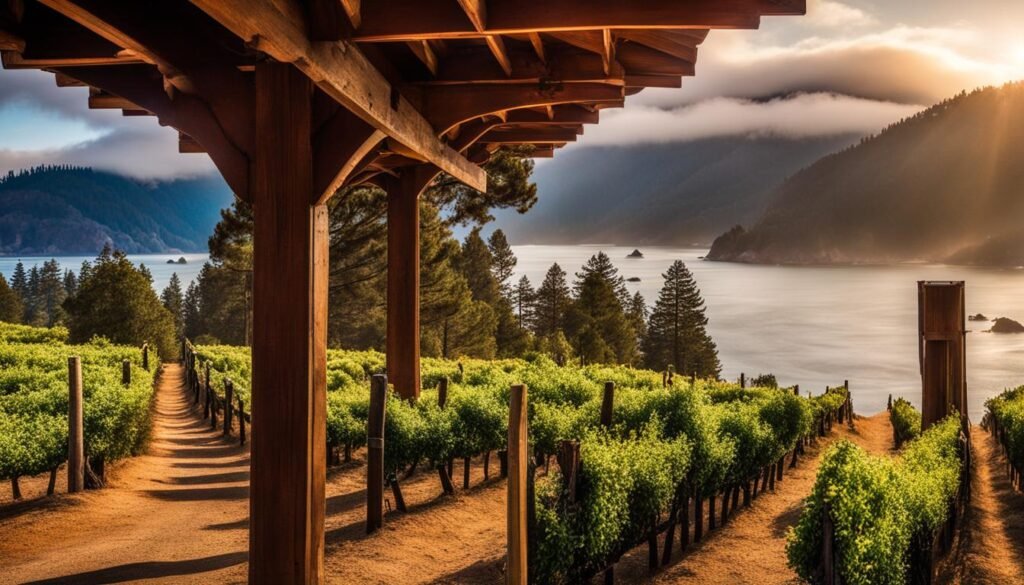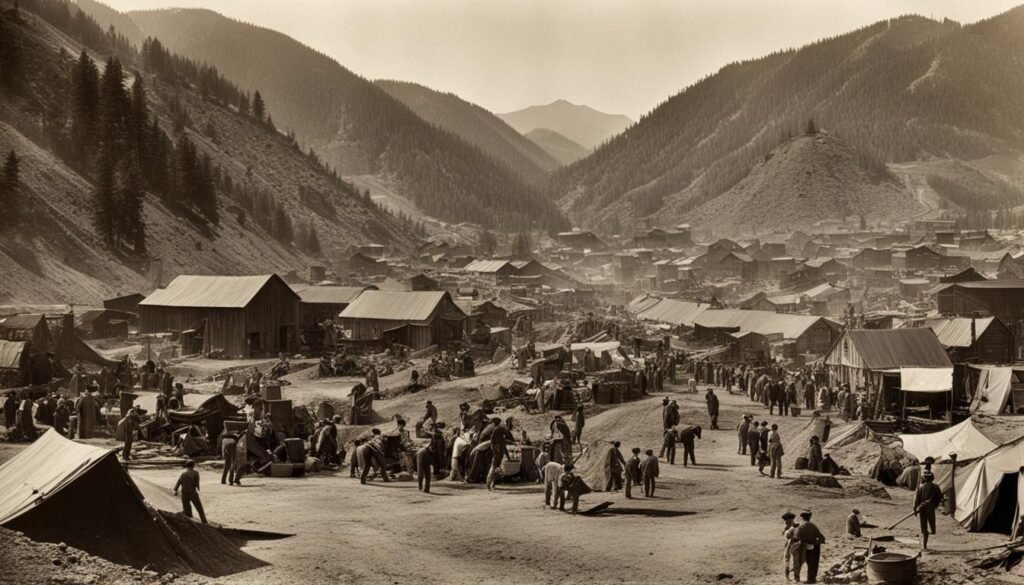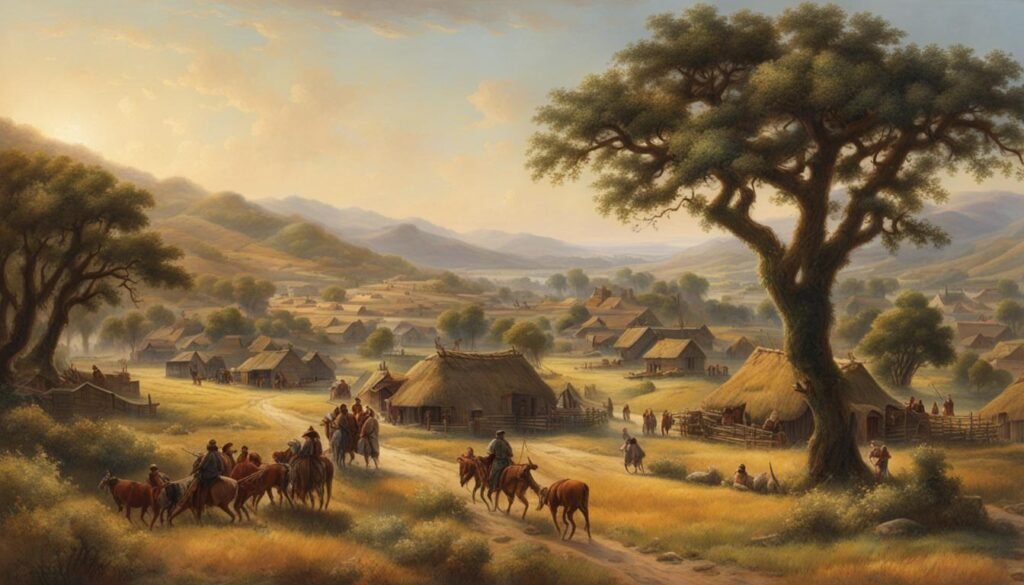California’s geography is a true marvel, offering a diverse and stunning landscape that captivates residents and visitors alike. Spanning over 160,000 square miles, the state is blessed with a range of physical features that make it a treasure trove of natural wonders.
The geographical features of California are as breathtaking as they are diverse. From majestic mountains and lush valleys to sprawling deserts and a picturesque coastline, the state’s terrain is truly remarkable. Its unique climate, shaped by the interaction of land and sea, gives rise to a multitude of ecosystems and habitats, making California the most biodiverse state in the country.
As we explore the different parts of California, we encounter a variety of landscapes that showcase the beauty of the geographic location. Iconic palm trees sway gently in the breeze, wildflowers bloom in a riot of colors, and the captivating vistas leave a lasting impression on all who witness them.
Key Takeaways:
- California’s geography spans over 160,000 square miles, offering a vast and diverse landscape.
- The state is known for its physical features, including mountains, valleys, forests, deserts, and coastline.
- Its unique climate and geologic history contribute to its status as the most biodiverse state in the country.
- California’s natural wonders, such as palm trees and wildflower blooms, are a testament to its rich geography.
- The state’s terrain is visually captivating and a source of inspiration for nature enthusiasts and explorers.
Exploring California’s Natural Wonders
California is a treasure trove of natural wonders waiting to be explored. From the stunning landscapes of Southern California to the picturesque scenes of Northern California, the state offers a plethora of breathtaking sights and unique experiences.
Southern California Geography
In Southern California, one can discover the fascinating La Brea Tar Pits. This renowned site is home to a collection of fossilized vertebrates, including the famous dire wolves. Explore the fascinating history and marvel at the ancient remains that provide a glimpse into the region’s past.
Venture into Scott Valley’s Marble Mountain Wilderness area, where a diverse landscape awaits. Experience the beauty of deciduous oaks and blooming California dogwood trees as you hike through this natural paradise. Don’t miss the opportunity to see the unique weeping spruce, adding an enchanting touch to this picturesque wilderness.
Head east of Yosemite National Park to Mono Lake, a truly extraordinary destination. This saline lake supports a unique ecosystem, filled with trillions of brine shrimp and alkali flies. Witness the mesmerizing beauty of this sustainable environment and learn about the delicate balance that exists within it.
Northern California Geography
In Northern California, visitors can immerse themselves in the wonders of the Crystal Range near Lake Tahoe. Marvel at the vibrant blooms that adorn the mountains, creating a colorful spectacle. As the day comes to a close, watch the sunsets paint the sky with breathtaking hues, creating an unforgettable experience.
Whether you choose to explore the natural wonders of Southern or Northern California, each region offers its own unique charm and beauty. Embark on an adventure and discover the diverse geography and natural wonders that make California a truly remarkable state.

California’s Stunning Physical Features
California is renowned for its diverse and captivating physical features that make it a visual marvel. From towering mountain ranges to picturesque coastlines, the state offers a unique blend of landforms that attract visitors from around the world.
One of the most notable physical features of California is the Sierra Nevada mountain range. Dominating the eastern part of the state, the Sierra Nevada boasts peaks soaring over 13,000 feet, including the iconic Mount Whitney, which stands as the highest point in the United States outside of Alaska.
The Cascade Range in California is home to distinguished peaks like Mount Shasta and Mount Lassen, showcasing the state’s volcanic history. Meanwhile, the San Bernardino Mountains in Southern California provide breathtaking vistas and opportunities for outdoor adventures.
Stretching along the Pacific coast, the California Coast Ranges and Transverse and Peninsular Ranges form a stunning backdrop for coastal landscapes. These mountain ranges offer magnificent views, lush forests, and diverse flora and fauna.
California is also known for its impressive network of rivers. The Sacramento and San Joaquin rivers, along with their tributaries, crisscross the state and contribute to its fertile river valleys. Additionally, California boasts several natural lakes and reservoirs, such as Lake Tahoe, Clear Lake, and Shasta Lake, which provide recreational opportunities and scenic beauty.
The state’s topography comprises a wide variety of landforms. Visitors can explore towering cliffs, serene beaches, volcanic lava beds, and lush river valleys, each contributing to California’s breathtaking scenery. Waterfalls, such as Yosemite Falls in Yosemite National Park, add to the state’s natural beauty.

The diverse physical features of California influence its climate and create distinct regions within the state. From the Mediterranean climate along the coast to the arid deserts in the southeastern part of the state, California experiences a wide range of weather patterns.
Overall, California’s physical features contribute to its status as one of the most visually stunning states in the United States, with diverse landscapes that attract nature enthusiasts and adventurers alike.
Regions of California’s Geography
California’s geography is incredibly diverse and can be divided into distinct regions, each with its own unique characteristics and natural wonders.
The Shasta Cascade Region
The Shasta Cascade region in the northeast is known for its volcanic mountains, stunning lava beds, and the expansive Shasta-Trinity National Forest. It offers outdoor enthusiasts a plethora of recreational opportunities, including hiking, camping, fishing, and wildlife observation.
The North Coast Region
The North Coast region of California features rugged cliffs, picturesque rocky beaches, and breathtaking views of the Pacific Ocean. This region is famous for its giant redwood forests that showcase the awe-inspiring beauty and grandeur of these majestic trees. Additionally, small towns with Victorian architecture dot the coastline, adding a charming and quaint atmosphere to the region.
The San Francisco Bay Area
The San Francisco Bay Area encompasses not only the iconic city of San Francisco but also the surrounding areas of Oakland, Berkeley, and the scenic countryside of Marin, Sonoma, and Napa counties. With its vibrant culture, diverse culinary scene, and stunning views of the Golden Gate Bridge, the San Francisco Bay Area offers a unique blend of urban and natural beauty.
The Gold Country Region
The Gold Country region in California’s foothills holds rich historical significance as the site of the 1849 Gold Rush. Today, visitors can explore historic mining towns, delve into the region’s fascinating history, and enjoy a thriving wine industry and picturesque farmlands. The American River, famous for its recreational activities like whitewater rafting, meanders through this region, adding to its natural allure.
The High Sierra Region
The High Sierra region is home to some of California’s most breathtaking mountain landscapes, including the world-renowned Yosemite, Sequoia, and Kings Canyon National Parks. Visitors to this region can hike through towering granite peaks, marvel at majestic waterfalls, and witness the stunning natural beauty of ancient giant sequoia trees.
The Central Valley Region
The Central Valley region of California is a fertile agricultural area that stretches from north to south. Known as the “breadbasket” of the state, this region produces a significant portion of California’s agricultural output. The Central Valley is adorned with expansive agricultural fields, which contribute to the state’s reputation as a major agricultural powerhouse.
The Central Coast Region
The Central Coast region of California is renowned for its sandy beaches, dramatic cliffs, and the scenic Monterey Bay. This region also features historic Spanish missions, charming coastal towns, and world-famous wine regions like Santa Barbara and Paso Robles. Visitors can explore coastal trails, spot marine wildlife, and indulge in the region’s culinary delights.
Southern California
Southern California is a diverse region that includes Los Angeles County, Orange County, the Inland Empire, and the vast deserts region, which encompasses Death Valley and Joshua Tree National Park. This region is known for its vibrant city life, beautiful coastal areas, and stunning desert landscapes. From the glitz and glamour of Hollywood to the tranquility of the Joshua Tree desert, Southern California offers a wide range of experiences for visitors.
San Diego County
San Diego County is located in the southernmost part of California and is famous for its coastal cityscape, beautiful beaches, and vibrant cultural scene. The county offers a diverse range of landscapes, including idyllic coastal areas, rugged cliffs, and scenic hiking trails. With its year-round mild climate, San Diego County is a popular destination for outdoor activities and beach lovers.
Conclusion
California’s geography is a diverse and scenic wonderland that never fails to impress. Whether it’s the towering mountains of the Sierra Nevada, the breathtaking coastlines, or the fertile valleys, this state offers a treasure trove of natural beauty. California’s physical features, from its majestic peaks to its sprawling beaches, make it a haven for nature enthusiasts and explorers.
However, alongside its stunning landscapes, California also faces environmental challenges. The state must address issues such as sustainable management of its abundant natural resources and the impacts of climate change. As we revel in the beauty of California’s geography, it is crucial to recognize the importance of preserving and protecting these natural wonders for future generations to enjoy.
By prioritizing sustainable practices, implementing conservation efforts, and raising awareness about California’s environmental issues, we can ensure that this breathtaking state continues to thrive. Let us appreciate and take care of the physical features, natural resources, and overall ecological balance that California has been blessed with.
FAQ
What is the geography of California like?
California has a diverse geography, including mountains, valleys, forests, deserts, and a coastline. It spans over 160,000 square miles and is known for its unique climate and landscapes.
What are some natural wonders to explore in California?
Southern California offers attractions like the La Brea Tar Pits, Marble Mountain Wilderness, and Mono Lake. In Northern California, you can explore the Crystal Range near Lake Tahoe.
Which physical features are found in California?
California is home to the Sierra Nevada and White Mountains, the Cascade Range with Mount Shasta and Mount Lassen, the San Bernardino Mountains, and the California Coast Ranges. It also has major rivers such as the Sacramento and San Joaquin, and lakes like Tahoe, Clear, and Shasta.
How is California’s geography divided into regions?
California has distinct regions, including the Shasta Cascade, North Coast, San Francisco Bay Area, Gold Country, High Sierra, Central Valley, Central Coast, Southern California (including Los Angeles County, Orange County, Inland Empire, and the deserts), and San Diego County.
What should we consider regarding California’s geography?
While enjoying California’s natural wonders, it is essential to consider the importance of preserving and protecting these resources, as the state faces environmental challenges and the impacts of climate change.







